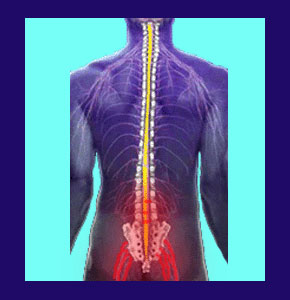
Sciatica in both legs, also called bilateral sciatica, is less common than symptoms that exist in only one leg, called unilateral sciatica. Bilateral sciatica comes in two distinct forms: true spinally-motivated pain and pain that is sourced outside of the lumbar and sacral nerve roots, often known as pseudo-sciatica. The latter type of pseudo-sciatica is actually far more prevalent than true spinally-enacted symptoms.
Sciatica is one of the most common chronic pain conditions and has a well-deserved reputation as an agonizing and cruel form of suffering. A large percentage of patients with severe sciatica cite their pain as the worst and most debilitating health issue they have ever faced. Many of these patients can not work, while some can barely stand, sit or walk comfortably for any length of time. The worst cases are usually self-confined to bed for long periods of time, since this is the only way for the victim to cope with the extreme misery of bilateral sciatica.
This essay explores the causes and symptoms of sciatica in both the left and right leg simultaneously. We will contrast spinal sciatica against pseudo-sciatica and also explain how the condition is both similar and different than unilateral sciatica.
Symptoms of Sciatica in Both Legs
Bilateral sciatica symptoms can be identical in expression, regardless of their causation. In fact, numerous completely different types of source mechanisms can enact the exact same expressions in the legs. This is one of the reasons why the true underlying cause of sciatica in both legs is so difficult to positively and accurately diagnose.
Pain is the primary suffering for most bilateral sciatica patients. This pain often feels like a burning sensation and can be experienced in the buttocks, groin, frontal or side thigh, rear thigh, knee area, ankle, calf or in any area of the feet. Some patients have pain in one region of the legs, while others have pain in multiple regions. A great number of patients describe shooting pains that seem to travel a linear pattern down the back or outer sides of the legs, with particular areas being more sensitive than others.
In addition to pain, patients might experience other neurological and muscular symptoms in the same or different areas of the anatomy. Tingling, also called paresthesia or pins and needles, is also a common linear expression, usually preceding or following times of severe pain. Feelings of numbness, heaviness or weakness in the legs are also commonly experienced. These latter symptoms can be subjective, meaning that they are mere perceptions, or objective, meaning that there are actual sensory and functional deficits present. Some patients demonstrate truly objective neurological symptoms, such as dorsiflexion deficit, more commonly known as dropped foot. Muscular cramping is also possible and can be terribly excruciating.
Symptoms might be predictable like clockwork for some patients, while others might find their symptoms to be highly variable. Symptoms might remain static and predictable, or static and unpredictable, over long timelines or may evolve definite trends and patterns. It is vital for patients to document the progression of the symptoms in order to best assist in diagnostic and treatment efforts.
Causes of Bilateral Sciatica
Bilateral sciatica in both legs can be caused by any number of conditions that affect the nerve roots which will eventually form the sciatic nerve (L4,L5, S1, S2 and S3), as well as conditions that affect the fully formed sciatic nerve itself. This is explained above in our clarification of spinally-motivated versus pseudo-sciatica.
Some of the more common causes of spinal sciatica include lumbar herniated discs, lumbar osteoarthritis leading to central spinal stenosis or neuroforaminal stenosis, lumbar spondylolisthesis, congenitally-narrowed spinal canals, extreme lumbar hyperlordosis and extreme thoracolumbar scoliosis.
Meanwhile pseudo-sciatica can come from sacroiliac joint problems, such as dysfunction or degeneration, piriformis compression of the sciatic nerve, called piriformis syndrome, diabetes, various neuromuscular diseases, local sciatica nerve injury or compression in the leg or may be enacted by ischemia, most often due to the psychosomatic interactions between brain and body.
As noted above, any or all of these causes can produce strikingly similar symptomatic patterns. Worse still, more than one possible cause is likely to be present, since lumbosacral degeneration is universal as people reach middle age. These factors pose true impediments to proper diagnostic processing, but can be overcome by knowledgeable care providers who can objectively look at the possible causative sources and narrow them down using medical imaging, nerve conduction testing, clinical examination and symptomatic correlation. Skipping the inclusion of any of these steps will increase the odds for misdiagnosis exponentially, as sciatica treatment statistics clearly demonstrate.
Sciatica in Both Legs Comparison
Bilateral spinally-motivated sciatica is far less common than bilateral pseudo-sciatica. This is logical since it is rare that structural lumbosacral pathologies will affect both sides of the spinal column, but it is possible. Pseudo-sciatica is more often seen in bilateral presentation, but this also depends on the underlying causative process. Piriformis syndrome is more common in unilateral expressions, while diabetes and neuromuscular disease origins commonly cause bilateral pain. Localized injury virtually never presents bilaterally, while ischemic sciatica can take on an infinite number of forms.
Regardless of causation, unilateral sciatica is far more common by a significant ratio. When bilateral pain is expressed, patients are split almost perfectly down the middle in terms of how each leg’s symptoms compares to the other. About half of the total number of patients report that their pain is similar or identical in both legs. Meanwhile the other half cite completely different pain from one leg to the other, with differences existing in many comparative categories including actual symptoms, locations experienced, severity and/or duration.





